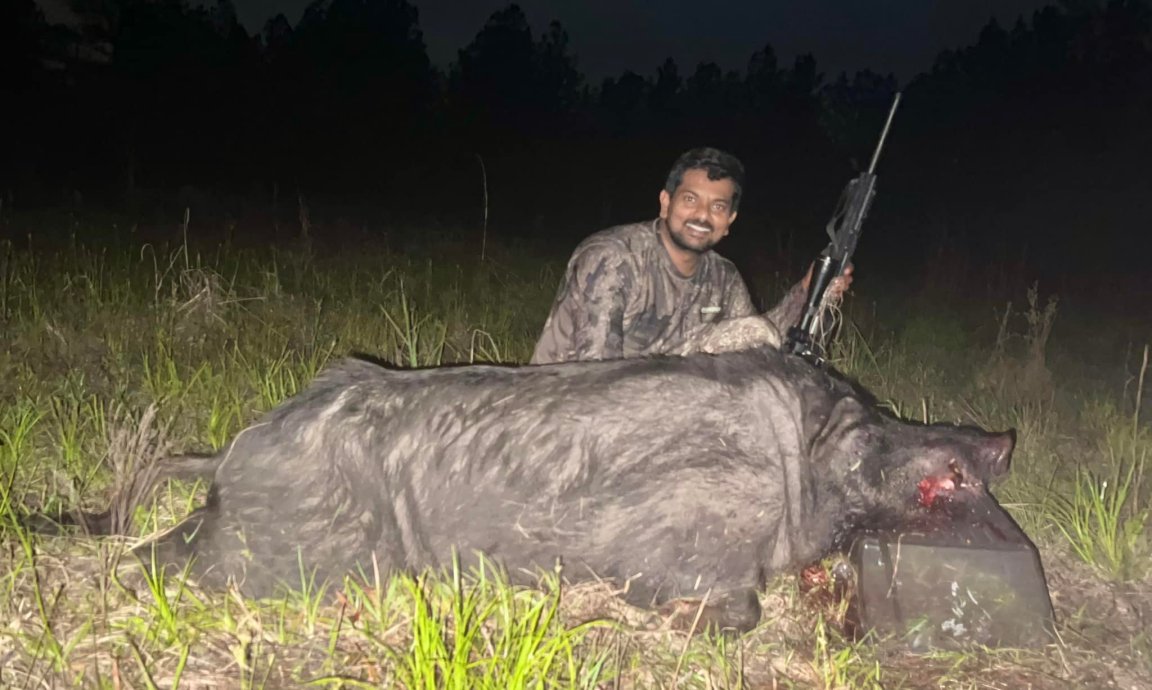Old—and oversized—wild hogs are smart and cagey. Equipped with remarkable senses of smell and hearing, they’ve got strong survival instincts. Wild pigs learn to stay away from humans and, when fully mature, they have no natural predators. For hunters who pursue them, big old boars with glistening white tusks are a challenge to hunt and a trophy to tag. That’s the way Arun Prakash Ramalingam, 41, sees it.
“I love hunting the giant old boar hogs,” says Ramalingam, an IT administrator in Jacksonville, Florida. “They are not easy to get close to, often are completely nocturnal, and are incredibly tough animals. They can be bad-tempered, too, and are equipped to fight with powerful bodies and sharp tusks.”
Ramalingam has taken many hogs over the years, so when he got a call from a buddy about a giant boar that was particularly destructive, he jumped at the invitation.
“My friend Matt Joseph has a 300-acre family farm north of the Okefenokee Swamp,” says Ramalingam. “He called me and said there was a group of wild hogs that moved onto his farm and were ripping up his fields. A couple of the hogs were big, and he had game camera photos of a giant of boar, and asked if I wanted to hunt it.”
Trail camera photos revealed the hog was all head and shoulders—just a giant of a tusker boar. Late in the afternoon on April 14, Ramalingam drove to the farm ready to hunt. He’d chosen to sit in a pine tree with the wind in his favor from the dense and tangled timbered area where the hogs lived. He climbed about 15 feet into the pine and waited for dusk from his saddle. As the sun began to set several deer wandered out into the field, which he took as a good sign. Right at dusk, a lone hog stepped into the field. It was a big pig, but Ramalingam passed since he was certain it wasn’t as big as the boar he’d seen in his friend’s trail camera photos.
Soon the first pig left the field, and only a couple minutes later Ramalingam heard grunting and squealing in the woods. He believed the hogs were coming toward the rooted field, right on time. At about 9 p.m. Ramalingam spotted faint movement in the open field, and checked it with his thermal binocular. There were about a dozen hogs of varied sizes, including two big boars.
“But one was easily bigger, very muscular with huge shoulders and head,” says Ramalingam.
Ramalingam raised his Ruger and steadied his scope on the hog while using night vision optics.
“I usually shoot hogs in the neck, but I didn’t want that big boar running off into the brush and I’d have to track him,” Ramalingam says. “So I aimed at his head, and squeezed the trigger when he turned just right at about 100 yards.”
The Hornady ELD-X 143 grain bullet hit the hog in the eye and passed through its skull, dropping it instantly.
Some other hogs lingered in the field, and Ramalingam could have shot another pig or two. But he knew he had plenty of work to do with the one giant already down. He was alone, in the dark, miles from town.
“I could see him laying in the field with my night vision optics, and knew I had my work cut out for me getting him out and to the processor,” Ramalingam says.
He climbed down from the pine, went to the hog, and tried to arrange it for a photo.

“I could barely move the hog,” Ramalingam says. “He was massive, and I could hardly set him up for photos. I’ve shot a lot of good pigs, but this one was a giant, at least 350 pounds, maybe more, and he was solid muscle, from his flanks to his shoulders and chest. A real beast.”
Ramalingam hauled out the hog with his truck and he and his friends loaded it up for the trip to the processor to turn it into sausage.
Read Next: How to Clean a Coyote Hide in Your Washing Machine
“I’m going to make a European mount of the boar skull with tusks like I’ve done to other hogs,” says Ramalingam. “They make an impressive mount, and this one is far bigger than any other hog I’ve taken.
Ramalingam plans to return to his pal’s field—this time with his 10-year-old son, Kavin.
“Kavin has shot hogs,” Ramalingam says of his son, “But not a real big boar, and he’s ready.”
